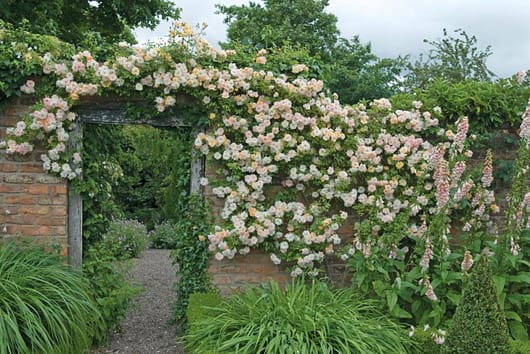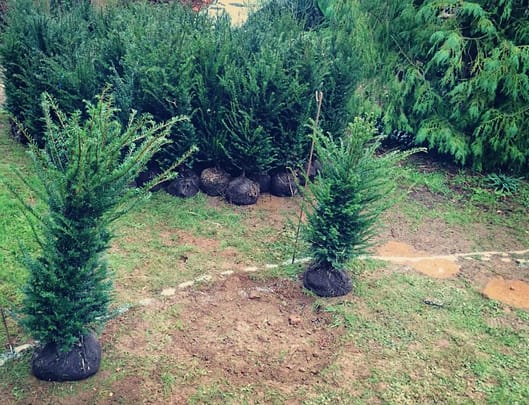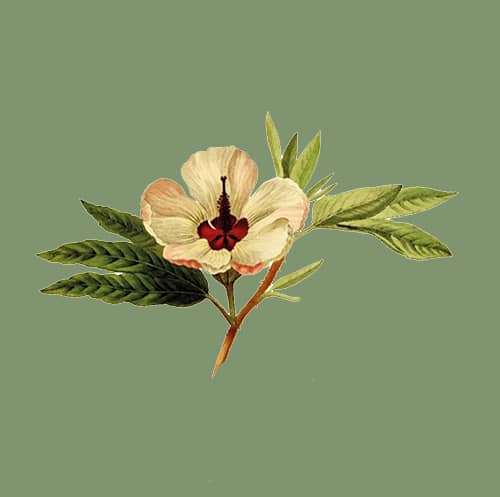Late-autumn through winter is the perfect time for planting bare-root trees, roses and shrubs, but why do we plump for bare-root planting at this time of year? What are the benefits? And when exactly is the best time to plant your bare-root bonanza?
It takes imagination to envisage bare-root stock in full bloom, when they arrive a tangle of contorted roots on show and stripped of their leafy mantle, but there are many reasons that we choose bare-root plants for the gardens we design or care for.
Bare-root planting takes place, in the main from mid-November until March. As the days become shorter and the temperature drops, plants become dormant. There is less sunlight for them to convert into food, and what energy they can convert is needed just to help the plant survive the freezing depths of winter. Plants sense this drop in their food supply and begin to divert their energy away from growing lush and verdant foliage (which would mean there is more of the plant to keep from freezing), and instead, they pour their efforts into forming strong, healthy roots. This is why it’s the perfect time to transplant them bare-root, as it causes the least stress and damage to a plant, as well as offering the greatest opportunity to form a well-established root mass.

It gives a plant the best potential starting point from which to spring into action as the warmer season arrives.
To give them the very best chance to establish, we tend to prefer to plant bare-root stock before the end of January, whilst there is still some warmth in the soil, as this gives our carefully hand-picked stock the longest period to concentrate on forming robust, fibrous, rootballs and a good chance to anchor solidly into their new site.
But this is by no means is the only benefit to planting bare-root.
A far greater array of varieties are available in bare-root rather than potted specimens and they are considerably better value for money. The nurseries we source from specialise in bare-root stock at this time of year, as they don’t have the added expense of buying pots or the extra delivery charges for transporting containers and compost, which in turn means those expenses aren’t passed onto you. Container-grown plants are also a good deal more labour-intensive to grow, requiring more watering, feeding and re-potting, as well as taking up more space, all of which increases the cost of producing them.
Removing the need for plastic pots is better for the environment too, of course, but perhaps the most important benefit of all is that bare-root planting produces strong, healthy plants. When plants are grown in containers their roots tend to circle round and round in the pot, and once sufficiently grown, to the size the pot allows, they must be transplanted into bigger and bigger pots until they are ready to go into the ground.
Plants that are grown for bare-root supply are often grown in nursery beds and are only uprooted when they’re ready for delivery. This means that their roots are freer to grow out in all directions, as opposed to their containerised cousins. Growing directly in the ground lends plants the opportunity to come into contact with a network of micro-organisms that encourage more efficient growth and can mean up to 200% more root mass. In turn, larger root-masses increase the amount of water that a plant can take up from the soil and all of this allows bare-root plants to settle and establish quicker, resulting in more vigorous growth.

Roses are well-suited to bare-root planting
Many types of plants can be supplied bare-root, from trees and shrubs to perennials. The most commonly known are fruit trees such as apple, pear, cherry and quince, as well as hedging plants, trees and roses. It really is a brilliantly efficient, effective, economical and environmentally sound way to bring new plants into your garden without compromising on quality. The rose-wizards at David Austen Roses are our prefered bare-root rose supplier specifically for the excellence of their plants, and because of the depth of their knowledge and experience, they are also who we choose to provide specialist, professional rose care training to our team.
There is one downside to using bare-root specimens though and that is the speed at which they need to be planted. It’s imperative to keep their roots moist, so our horticulturalists get our bare-root deliveries in the ground as soon as possible to prevent them drying out, which can make for a long day of digging, depending on the number of plants ordered, preparing the plants and beds with treatments to enhance growth and sustain soil condition. Then watch as these handfuls of bald twigs burst into life and flourish, transforming empty patches of beds into botanical paradise is its own reward.

Marking out the line of a hedge, ready for planting with rootballed taxus
For instant impact, many clients like a more mature plant at this time of year, to do this we use rootballed plants. Larger, more mature specimens of trees and shrubs, included trained forms such as pleached panels are field-grown in beds, just as with plants for bare-root supply, however, they are lifted from the ground with the surrounding soil intact and wrapped with hessian to protect the rootball and support the mass of their roots. This prevents them from damage or drying out.
Rootball specimens may also have a wire-basket or frame to support them during growth. The wire-basket distributes the weight evenly on lifting and transporting, so they retain their form and structure as we transplant them into the garden. Rootballed plants come with all the benefits of bare-root specimens in terms of cost-effectiveness, varietal availability and plant growth, but with the added benefit of providing an immediate garden revamp.

Instant Impact: The same rootballed hedge just a few months later
Motivated to make more of your garden this winter? Lost a few plants during the summer’s drought? Our team are busy helping keep gardens flourishing with bare-root stock, carefully selected from our specialist suppliers.
Talk to us about how our work this winter can have your garden ready to burgeon this spring.
Images of bare root rose planting and rambling rose ‘Phyllis Bide’ over a doorway, all courtesy of David Austen Roses


